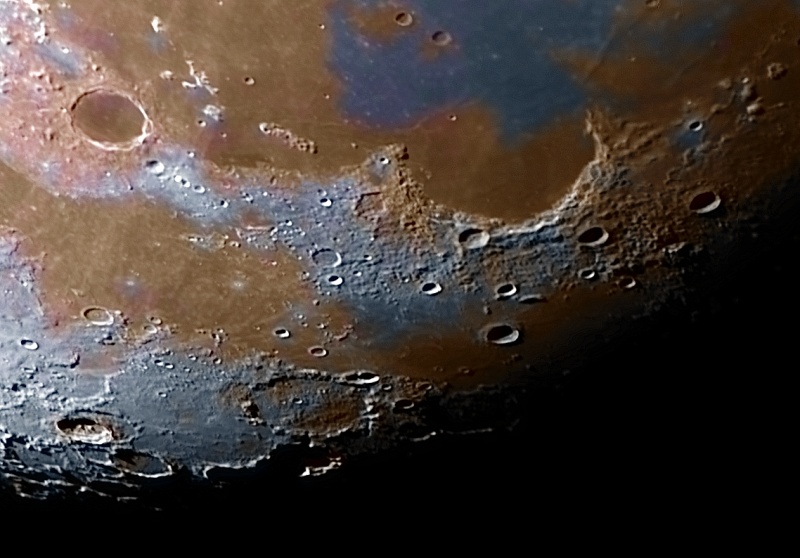Date: 2019-11-08
Time: 21:13h TU (first luminance image)
Lunation: 11.83 days
Phase: 40.3º
Distance: 400,552 kms
Apparent diameter: 29.83º
Colongitude: 50.9º
Illumination: 88.1%
Rise: 15:13h CET
Transit: 21:05h CET
Set: 2:03h CET
Mare Imbrium (Latin for "Sea of Showers" or "Sea of Rains") is a vast lava plain within the Imbrium Basin on the Moon and is one of the larger craters in the Solar System. The Imbrium Basin formed from the collision of a proto-planet during the Late Heavy Bombardment. Basaltic lava later flooded the giant crater to form the flat volcanic plain seen today. The basin's age has been estimated using uranium–lead dating methods to 3938 ± 4 million years ago.
With a diameter of 1145 km, Mare Imbrium is second only to Oceanus Procellarum in size among the maria, and it is the largest mare associated with an impact basin.
Plato is a lava-filled lunar impact crater on the Moon. Its diameter is 101 km. It is located on the northeastern shore of the Mare Imbrium, at the western extremity of the Montes Alpes mountain range. In the mare to the south are several rises collectively named the Montes Teneriffe. To the north lies the wide stretch of the Mare Frigoris. East of the crater, among the Montes Alpes, are several rilles collectively named the Rimae Plato.
The age of Plato is about 3,840 million years, only slightly younger than the Mare Imbrium to the south. The rim is irregular with 2-km-tall jagged peaks that project prominent shadows across the crater floor when the Sun is at a low angle. Sections of the inner wall display signs of past slumping, most notably a large triangular slide along the western side. The rim of Plato is circular, but from the Earth it appears oval due to foreshortening.
The flat floor of Plato has a relatively low albedo, making it appear dark in comparison to the surrounding rugged terrain. The floor is free of significant impact craters and lacks a central peak. However, there are a few small craterlets scattered across the floor.
Source: Wikipedia
Mare Imbrium (en latín, "Mar de lluvias") es una vasta llanura de lava dentro de la cuenca de Imbrium en la Luna y es uno de los cráteres más grandes del Sistema Solar. La cuenca de Imbrium se formó a partir de la colisión de un proto-planeta durante el bombardeo pesado tardío. La lava basáltica inundó el cráter gigante para formar la llanura volcánica plana que se ve hoy. La edad de la cuenca se ha estimado utilizando métodos de datación de uranio-plomo hasta 3938 ± 4 millones de años.
Con un diámetro de 1145 km, Mare Imbrium ocupa el segundo lugar después de Oceanus Procellarum en tamaño entre la maría, y es el mar más grande asociado con una cuenca de impacto.
Plato es un cráter de impacto lunar lleno de lava en la Luna. Su diámetro es de 101 km. Se encuentra en la costa noreste del Mare Imbrium, en el extremo occidental de la cordillera de los Montes Alpes. En el mar al sur hay varias rises llamadas Montes Teneriffe. Al norte se encuentra el amplio tramo de Mare Frigoris. Al este del cráter, entre los Montes Alpes, se encuentran varios rilles llamados Rimae Plato.
La edad de Plato es de unos 3.840 millones de años, solo un poco más joven que el Mare Imbrium en el sur. El borde es irregular con picos de 2 km de altura que proyectan sombras prominentes a través del fondo del cráter cuando el Sol está en un ángulo bajo. Las secciones de la pared interior muestran signos de caída en el pasado, sobre todo un gran deslizamiento triangular a lo largo del lado occidental. El borde de Plato es circular, pero desde la Tierra parece ovalado debido a la inclinación.
El fondo plano de Platón tiene un albedo relativamente bajo, por lo que parece oscuro en comparación con el terreno accidentado circundante. El piso no tiene cráteres de impacto significativos y carece de un pico central. Sin embargo, hay algunos pequeños cráteres esparcidos por la superficie.
Fuente: Wikipedia |
|

